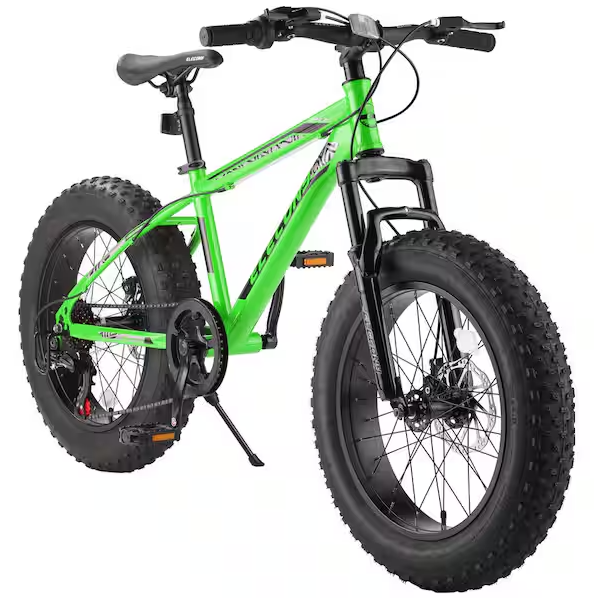Notifications

8 minutes, 31 seconds
-198 Views 0 Comments 0 Likes 0 Reviews

Cycling is more than just a mode of transportation — it’s a lifestyle, a fitness tool, and a gateway to adventure. But if you've ever tried riding through snow, sand, or loose gravel on a standard bike, you’ve likely learned the hard way that not all bikes are built for every terrain. That’s where fat tire bike come in.
With their ultra-wide tires and rugged design, fat tire bikes allow you to explore places that traditional bikes simply can’t reach. Whether you're carving through snow-covered trails, rolling over sandy beaches, or powering through muddy backroads, fat bikes are built to handle it all with confidence and ease.
Fat tire bikes are designed to perform in environments that would stop other bikes in their tracks. Their signature feature is their wide tires — usually 3.8 inches or more in width — which provide greater surface contact and lower pressure than traditional tires.
This translates into:
Better flotation on soft terrain
Increased stability and balance
Improved traction and grip
Shock absorption without needing heavy suspension systems
In essence, fat bikes are the off-roaders of the cycling world — slow, strong, and unstoppable.
If you're still on the fence about fat tire bikes, consider the wide range of benefits they offer for various riders and conditions.
With a fat tire bike, your riding isn’t restricted by weather or surface conditions. Rain-soaked trails, snowy streets, muddy fields, and sandy shores all become fair game. This opens up a world of exploration year-round.
Fat tires naturally absorb shocks and vibrations, meaning the ride is much smoother even without added suspension. This makes them ideal for long, leisurely rides or for those who prefer a more comfortable cycling experience.
The extra width of the tires gives fat bikes a larger footprint, which adds balance and control. This makes them particularly beginner-friendly, reducing the chance of tipping and making it easier to learn off-road skills.
Fat biking demands more from your muscles. The wide tires and increased rolling resistance make for a challenging ride, which helps build strength, endurance, and cardiovascular fitness.
Fat tire bikes are designed for versatility. Here are a few terrains where they truly shine:
The low-pressure tires grip well on snow-packed trails and icy paths, making winter cycling not just possible, but enjoyable.
While most bikes struggle and sink into sand, fat bikes stay on top, allowing riders to cruise along the shoreline with ease.
Fat tires cut through mud and offer strong traction even on slick trails, giving you more control and fewer wipeouts.
The wide tires help absorb impact and provide better balance on rocky or uneven surfaces — ideal for trail rides or mountainous terrain.
If you're considering buying a fat tire bike, here are a few components that can impact your riding experience:
Wider tires (4.5" to 5") are better for snow and sand, while narrower ones (3.8" to 4.3") are great for trail use. Some riders switch between tire types based on season or location.
Steel: Strong and smooth but heavier.
Aluminum: Lightweight and affordable.
Carbon Fiber: High-performance but more expensive.
Titanium: Durable, light, and comfortable, though pricey.
Most fat bikes are rigid, which keeps them simple and lightweight. However, if you ride rough trails regularly, look for models with a front suspension fork for added comfort.
Choose a bike with a wide gear range if you plan to climb hills or carry gear. A 1x or 2x drivetrain will typically be enough for most fat bike use cases.
Hydraulic disc brakes are recommended for fat bikes due to their superior stopping power in wet, snowy, or muddy conditions.
Fat bikes are rugged machines, but they still require care — especially because they’re often exposed to harsh environments:
Clean regularly to remove mud, sand, or salt residue.
Check tire pressure before every ride — optimal PSI varies depending on terrain.
Lubricate the chain and moving parts, especially in snowy or wet weather.
Inspect brakes and cables to ensure proper function.
Keeping your fat bike in good condition will extend its life and keep your rides smooth and safe.
Fat tire bikes are surprisingly versatile and cater to a variety of riders:
Urban Commuters: Those navigating potholes, snow, or poorly maintained roads.
Outdoor Enthusiasts: Riders looking to explore nature in all seasons.
Fitness Cyclists: People looking for a more challenging ride.
Bikepackers: Cyclists who need a reliable bike for long, gear-heavy trips.
Beginners: New riders who want a stable, forgiving platform to build confidence.
Here are some trusted brands known for producing high-quality fat bikes:
Surly – Known for rugged, steel-framed fat bikes like the Pugsley and Ice Cream Truck.
Salsa – Offers adventure-ready fat bikes such as the Mukluk and Beargrease.
Trek – The Farley series blends performance with comfort for year-round riding.
Specialized – Fatboy models offer a solid mix of durability and speed.
Canyon – A newer entry with sleek, high-tech fat bikes for various terrain.
A fat tire bike isn’t just a bicycle — it’s a ticket to freedom. Freedom from weather limitations, freedom from terrain restrictions, and freedom to explore your world in new and exciting ways.
Whether you’re a weekend warrior, a winter commuter, or a trailblazing adventurer, fat tire bikes provide the stability, versatility, and ruggedness to go wherever the ride takes you. If you’ve ever dreamed of biking beyond the usual path — onto snowfields, into forests, across beaches — now is the time to turn that dream into reality.

